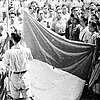Police actions (Indonesia)
| History of Indonesia |
|---|
 |
| Timeline |
|
|
The police actions (Dutch: Politionele acties, also politiële acties),[1] were two major military offensives that the Netherlands carried out on Java and Sumatra against the Republic of Indonesia during its struggle for independence in the Indonesian National Revolution.[2][3] In Indonesia they are collectively known as the Dutch Military Aggressions (Indonesian: Agresi Militer Belanda), although the less common translation Aksi Polisionil is also used.
In Dutch historiography and discourse, the entire Indonesian War of Independence was for a long time euphemistically referred to as 'the police actions', as coined by the government of the time. In the Netherlands, the impression prevailed that there had only been two separate, short-lived police actions, intended to restore Dutch authority over a rebellious overseas territory. This perspective ignores the fact that between the arrival of Dutch troops in March 1946 and the cession of sovereignty in December 1949, there had been a full-scale military occupation and an ongoing counterinsurgency involving 120,000 conscripts.[4]
Operation Product
[edit]Operation Product took place between 21 July and 5 August 1947.[2] The Dutch greatly reduced and fragmented Indonesian-controlled territories, with a particular focus on the oil fields and rubber plantations of Sumatra, and the sugar plantations and economic infrastructure of Java.[5] The offensive excluded an attack on the city of Yogyakarta, wartime seat of the Republican government, due to high expected costs of urban warfare.
The actions of the Mariniersbrigade on Java were further divided into an amphibious landing on Pasir Putih, East Java (Product North), amphibious operations in the Meneng Bay (Product East), and a southward offensive launched from Porong (Product South).[6]
Operation Kraai
[edit]Operation Kraai (Operation Crow) took place between 19 December 1948 and 5 January 1949.[7] It resulted in the Dutch capture of Yogyakarta, the arrests of much of the Indonesian leadership, and the exile of what remained of the Republican government to Sumatra.[5]
Actions of the Mariniersbrigade on East Java during this offensive are referred to as Operation Zeemeeuw (Operation Seagull).[6]
Other operations
[edit]Eclipsed by the scale and notoriety of Product and Kraai, other Dutch offensive operations of the Indonesian Revolution include:[6][8]
- Operation Trackman (Gresik, 10 August 1946)
- Operation Quantico (Gresik, 19 August 1946)
- Battle of Margarana (Marga, 20 November 1946)
- South Sulawesi campaign (10 December 1946–21 February 1947)
- Operation Ideaal (Mojokerto, 17 March 1947)
- Malang Operation (30 June 1947)
- Operation Carthago (Asembagus, 5 September 1947)
- Operation Albatros (Pacitan, 12 January 1949)
- Operation Otter (Prigi Bay, 7–18 April 1949)
- Paciran Operation (20–28 May 1949)
See also
[edit]- Kalimantan Physical Revolution (1945–1948)
- Battle of Medan (1945–1946)
- Battle of Ambarawa (1945)
- Kolaka incident (1945)
- East Sumatra revolution (1946)
- Gerbong Maut incident (1947)
- Rawagede massacre (1947)
- Rengat massacre (1949)
- Yogyakarta and Surakarta Offensive (1949)
References
[edit]- ^ "CD-ROM version". Encarta Encyclopedie Winkler Prins (in Dutch). Microsoft Corporation/Het Spectrum. 1993–2002.
- ^ a b Vickers, Adrian (2005). A History of Modern Indonesia. Cambridge: Cambridge University Press. p. 99. ISBN 0521542626.
- ^ Ricklefs, Merle Calvin (1991). A history of modern Indonesia since c. 1300 (2 ed.). Basingstoke; Stanford, California: Palgrave; Stanford University Press. p. 225. ISBN 033357690X.
- ^ Vanheste, Tomas (15 July 2021). "Hoe David Van Reybrouck een poffertje proeft en het Nederlandse zelfbeeld corrigeert". de-lage-landen.com (in Dutch). De lage landen. Retrieved 13 June 2023.
- ^ a b Kahin, George McTurnan; Kahin, Audrey (2003). Southeast Asia: A Testament. London: Routledge Curzon. ISBN 0415299756.
- ^ a b c Hornman, W.J.M. (1995). De Mariniersbrigade: De Geschiedenis (in Dutch). Hoevelaken: Verba. ISBN 9055131687.
- ^ "Operatie Kraai" (in Dutch). Network of War Collections. Retrieved 3 June 2022.
- ^ "Strijd in Nederlands-Indie (1945 tot 1950, algemeen)". nederlandsekrijgsmacht.nl (in Dutch). Archived from the original on 2023-02-01. Retrieved 3 June 2022.
Further reading
[edit]- Heijboer, P. (1979). De politionele acties: de strijd om 'Indië', 1945/1949 (in Dutch). Haarlem: Fibula-van Dishoeck. ISBN 9022838722.
- Doorn, J.A.A. van; Hendrix, W.J. (1983). Het Nederlands/Indonesisch conflict: ontsporing van geweld (in Dutch). Amsterdam: De Bataafsche Leeuw. ISBN 9067070211.
- Teitler, G.; Groen, P.M.H. (1987). De politionele acties (in Dutch). Amsterdam: De Bataafsche Leeuw. ISBN 9067071390.
- Jong, J.J.P. de (1988). Diplomatie of strijd: een analyse van het Nederlands beleid tegenover de Indonesische Revolutie, 1945–1947 (in Dutch). Meppel: Boom. ISBN 9060098382.
- Jong, L. de (1988). Het Koninkrijk der Nederlanden in de Tweede Wereldoorlog, volume 12 (in Dutch). The Hague: Sdu.
- Teitler, G.; Hoffenaar, J. (1990). De politionele acties: afwikkeling en verwerking (in Dutch). Amsterdam: De Bataafsche Leeuw. ISBN 9067072354.
- Groen, P.M.H. (1991). Marsroutes en dwaalsporen: het Nederlands militair-strategisch beleid in Indonesië, 1945–1950 (in Dutch). The Hague: Sdu. ISBN 9012068746.
- Liempt, A. van (1994). Een mooi woord voor oorlog: ruzie, roddel en achterdocht op weg naar de Indonesië-oorlog (in Dutch). The Hague: Sdu. ISBN 9012067014.
- Bank, J.T.M. (1995). De Excessennota: nota betreffende het archiefonderzoek naar de gegevens omtrent excessen in Indonesië begaan door Nederlandse militairen in de periode 1945–1950 (in Dutch). The Hague: Sdu. ISBN 9012082234.
- Jong, J.J.P. de (2011). Avondschot: hoe Nederland zich terugtrok uit zijn Aziatisch imperium (in Dutch). Meppel: Boom. ISBN 978-9461052704.
- KITLV; NIMH; NIOD Institute for War, Holocaust and Genocide Studies (2022). Beyond the Pale: Dutch Extreme Violence in the Indonesian War of Independence, 1945–1949. Amsterdam: Amsterdam University Press. ISBN 978-9463726481.

